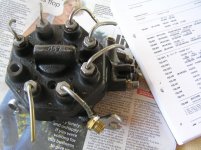Some while ago, I posted details of how I checked the efficiency in operation of some eight fuel injectors. Now, I have endeavoured to find this post/thread to bring you up to date with the latest but, alas, I have not been able to find it.
In the course of this search, I have come to realize that many of our threads and posts are badly in need of re-categorizing, but that's something for another day. However, for the time being, here is an updated version of my testing efforts.

Quite simply, having the necessary spare injection lines, I shortened seven of those and fitted them to the Fuel Divider. Ignore the 'loose' unit, it is there merely for illustration purposes. To carry out the test, one must use the one on the car. I sealed off those small lines in order to retain fuel pressure in the system, but I used the eighth outlet port to connect a longer line that each injector, in turn, could also be fitted to. The advantage of this method is that proper pressure is present at all times, and the idea is to test each injector one at a time to observe the spray pattern. In order to have the required fuel pressure at all times, you will need ignition on, the electrical plug disconnected on the inlet manifold, and then depress the steel fuel divider diaphragm to observe the spray pattern. It's important to know what you are looking for and to what extent, and also where, you depress that diaphragm. Depression closest to the fuel divider body gives you the most steady and uniform spray action, and it is also important that one should just gently open (after cracking the injector) the diaphragm and hold it in a steady position and then look at the spray pattern. This should consist of a fine mist, no drips or 'spitting' flow and whilst one can quite frequently get a good pattern when pushing the diaphragm down hard, that sort of opening would constitute high throttle operation. That's not what you want. Most of our driving is done below two thousand revs, a steady throttle and therefore small diaphragm opening. That is the time when you want your car to be the most economical. I hope all of this makes sense.
Incidentally, with the method just outlined, it is easy to check your fuel divider. Simply rotate the line used for testing the injector from one to the next, and leave the same injector in place. If there is any great variation in diaphragm pressure response, you may have a faulty divider outlet port. Regards Styria
In the course of this search, I have come to realize that many of our threads and posts are badly in need of re-categorizing, but that's something for another day. However, for the time being, here is an updated version of my testing efforts.

Quite simply, having the necessary spare injection lines, I shortened seven of those and fitted them to the Fuel Divider. Ignore the 'loose' unit, it is there merely for illustration purposes. To carry out the test, one must use the one on the car. I sealed off those small lines in order to retain fuel pressure in the system, but I used the eighth outlet port to connect a longer line that each injector, in turn, could also be fitted to. The advantage of this method is that proper pressure is present at all times, and the idea is to test each injector one at a time to observe the spray pattern. In order to have the required fuel pressure at all times, you will need ignition on, the electrical plug disconnected on the inlet manifold, and then depress the steel fuel divider diaphragm to observe the spray pattern. It's important to know what you are looking for and to what extent, and also where, you depress that diaphragm. Depression closest to the fuel divider body gives you the most steady and uniform spray action, and it is also important that one should just gently open (after cracking the injector) the diaphragm and hold it in a steady position and then look at the spray pattern. This should consist of a fine mist, no drips or 'spitting' flow and whilst one can quite frequently get a good pattern when pushing the diaphragm down hard, that sort of opening would constitute high throttle operation. That's not what you want. Most of our driving is done below two thousand revs, a steady throttle and therefore small diaphragm opening. That is the time when you want your car to be the most economical. I hope all of this makes sense.
Incidentally, with the method just outlined, it is easy to check your fuel divider. Simply rotate the line used for testing the injector from one to the next, and leave the same injector in place. If there is any great variation in diaphragm pressure response, you may have a faulty divider outlet port. Regards Styria
Last edited:
